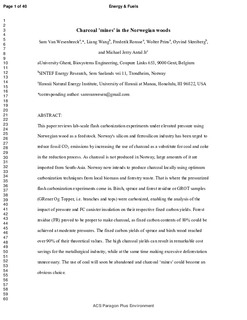| dc.contributor.author | Wesenbeeck, Sam Van | |
| dc.contributor.author | Wang, Liang | |
| dc.contributor.author | Ronsse, Frederik | |
| dc.contributor.author | Prins, Wolter | |
| dc.contributor.author | Skreiberg, Øyvind | |
| dc.contributor.author | Antal, Michael Jerry | |
| dc.date.accessioned | 2018-02-23T12:43:46Z | |
| dc.date.available | 2018-02-23T12:43:46Z | |
| dc.date.created | 2016-06-25T05:09:22Z | |
| dc.date.issued | 2016 | |
| dc.identifier.citation | Energy & Fuels. 2016, 30 (10), 7959-7970. | nb_NO |
| dc.identifier.issn | 0887-0624 | |
| dc.identifier.uri | http://hdl.handle.net/11250/2486760 | |
| dc.description.abstract | This paper presents lab-scale flash carbonization (FC) experiments under elevated pressure using Norwegian wood as a feedstock. The silicon and ferrosilicon industry of Norway has been urged to reduce fossil CO2emissions by increasing the use of charcoal as a substitute for coal and coke in the production process. Because charcoal is not produced in Norway, large amounts of it are imported from south Asia. Norway now intends to produce charcoal locally using optimum carbonization techniques from local biomass and forestry waste. That is where the pressurized FC experiments come in. Birch, spruce and corresponding forest residues (FRs) were carbonized, enabling the analysis of the impact of pressure and FC canister insulation on their respective fixed carbon yields. FRs proved to be proper to make charcoal, because fixed carbon contents of 80% could be achieved at moderate pressures. The fixed carbon yields of spruce and birch wood reached over 90% of their theoretical values. The high charcoal yields can result in remarkable cost savings for the metallurgical industry while, at the same time, making excessive deforestation unnecessary. The use of coal will soon be abandoned in the ferrosilicon industry, and charcoal "mines" could become an obvious choice. © 2016 American Chemical Society | nb_NO |
| dc.language.iso | eng | nb_NO |
| dc.rights | Navngivelse 4.0 Internasjonal | * |
| dc.rights.uri | http://creativecommons.org/licenses/by/4.0/deed.no | * |
| dc.title | Charcoal "Mines" in the Norwegian Woods | nb_NO |
| dc.type | Journal article | nb_NO |
| dc.type | Peer reviewed | nb_NO |
| dc.description.version | acceptedVersion | nb_NO |
| dc.rights.holder | Authors have copyright to accepted Version. | nb_NO |
| dc.source.pagenumber | 7959-7970 | nb_NO |
| dc.source.volume | 30 | nb_NO |
| dc.source.journal | Energy & Fuels | nb_NO |
| dc.source.issue | 10 | nb_NO |
| dc.identifier.doi | 10.1021/acs.energyfuels.6b00919 | |
| dc.identifier.cristin | 1364173 | |
| dc.relation.project | Norges forskningsråd: 193817 | nb_NO |
| dc.relation.project | Norges forskningsråd: 228726 | nb_NO |
| cristin.unitcode | 7548,70,0,0 | |
| cristin.unitname | Termisk energi | |
| cristin.ispublished | true | |
| cristin.fulltext | postprint | |
| cristin.qualitycode | 2 | |

